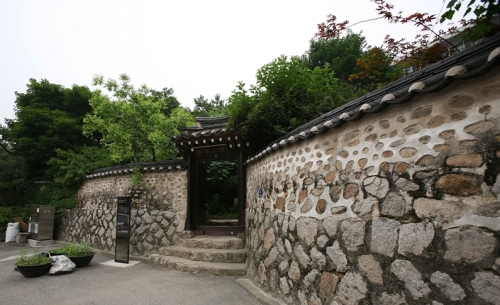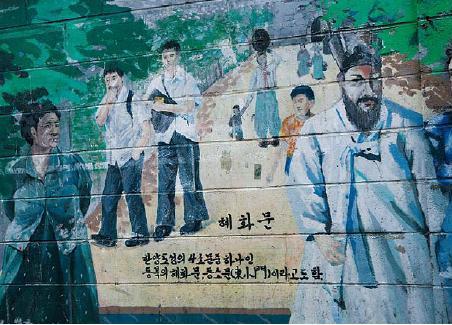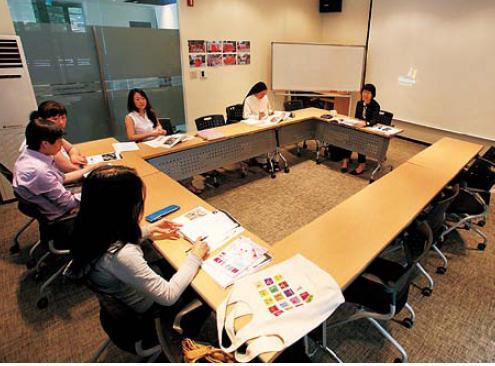This is the 85th in a series of articles highlighting tourism spots in Seoul. The guide for planning weekend trips in the capital city will help readers rediscover Seoul. — Ed.

Seongbuk-dong is referred to as the Beverly Hills of Korea, as many rich families live there. There are also many embassies and ambassadors’ residences. However, behind the obvious facade of Seongbuk-dong, there are many interesting things to see. Historical sites from Seoul’s modern era are hidden within the residential area. The Seongbuk-dong tour locates such sites and pieces them together like a puzzle to present a new image of this area.
*Authenticity of the traditional hanok -- Choi Sunu House
One place you should not miss is the Choi Sunu House (Registered Cultural Heritage No. 268). Among the houses in this area, I came across a well-built hanok. Choi Sunu may have passed away, but the people now taking care of this house came out to greet me.
The house was designated Citizens’ Cultural Heritage No. 1 by the National Trust Cultural Heritage Fund, and currently serves as the Hyegok Choi Sunu Memorial. Since the house is always taken care of, it is well-preserved and very neat. This house was built in the 1930s, Choi Sunu bought it in 1972 and lived here until he passed away in 1984.
Choi Sunu, an art critic and scholar, fully expressed his love for Muryangsujeon at Busuksa Temple in his book. His house is also a clear example of his love for hanok.
The ㄱ shaped “sarangchae” (men’s quarters) and the ㄴ shaped “anchae” (main building) together form a ㅁ shape. Signboards, pillars and the stone terrace harmonize well with the house. Its nature-friendly backyard is another highlight of the house. After looking around Osudang (午睡堂), so named because Choi Sunu used to take a nap there, I sat on the “toenmaru,” a kind of veranda. The back garden is much larger than the front yard and contains persimmon trees, chestnut trees, quince trees, oak trees, pine trees and small bamboo plants.
Choi Sunu used to put a white porcelain jar in front of the bamboo so that its shadows would fall across the jar on bright moonlit nights. As he enjoyed the shadows on the jar, he said, “Where could I find a more beautiful Oriental painting than this.”
Taking a cup of cool barley tea, I looked at the ivy covering the tall wall. There must be another world behind that wall. Within the walls of the Choi Sunu House, I felt isolated from the outside world. The house had been on the verge of destruction when the National Trust, a foundation established by citizens, bought it to preserve it. The tranquil and relaxed atmosphere of this hanok touched my heart. This is a place where I want to take an “Osu,” or nap.
*The birthplace of Sangheo Yi Taejun became a tea house, Suyeonsanbang, filled with delicate scents of tea.

From Choi Sunu House, I left the alley and started to walk towards the main street; I crossed the street here and entered the alley between the Seongbuk Multicultural Village Center and a pork cutlet restaurant. On my right was Suyeonsanbang. This is not a simple tea house, but the birthplace of Sangheo Yi Taejun. A tall grey brick wall, a firm-looking wooden door, and a small garden with overgrown leaves are the first things you notice about Suyeonsanbang. On my right is a well-built hanok and, on my left, is a modern, dimly lit building.
The garden is in the traditional Korean style and is bountiful with Korean wild flowers. The shape of the hanok and the signboards hanging are uncommon. The signboard saying “Ilgwanjeong” (一觀亭) was originally hung on the main upper floor, but is now hung at the gate. There’s a wind chime hanging under the eaves, like in a temple. The anchae was originally ㄱ shaped, the representative style of Seoul in the late Joseon Dynasty, but rooms were added at the back to give the house a 工 shape. An upper floor functioning as the sarangbang was added to the anchae. Also added were a kitchen and bathroom when the house was modernized. Munhyangnu (聞香樓) is famous for its signboard. Each character was collected from the calligraphy of Chusa Kim Jung hee and engraved on the signboard. The lines of the ridgepole and eaves are so sleek that they look like dancing butterflies.
What is the story of this house, where Yi Taejun lived for 14 years from 1933 to 1946? He was born in Cheolwon, Gangwon Province, and studied at Whimoon High School and then Sophia University in Japan. He made his debut as a writer by publishing “Omongnyeo” in the “Sidae Ilbo” and participated in “Guinhoe” (Group of Nine Writers). He then worked as an instructor at Ewha Womans University and was the director of the Department of Art and Science at Joseon Joonangilbo. During Japanese colonial rule, he was recognized as one of the best writers and led the cultural and arts fields. Right after the Korean War, he defected to North Korea. In this house, he wrote the short pieces “Dalbam” (Moonlit Night) and “Doldari” (Stone Bridge), the medium length novel “Cosmos Pineun Jeongwon” (Garden of Blooming Cosmos), and the full-length novels “Hwangjini” and “Wangja Hodong” (Prince Hodong). As the house became known to the public, visitors to the house kept increasing. Eventually, a friend of his opened the Suyeonsanbang tea house in the house and let people enter.
*Simujang, turning its back on the Japanese Government General of Korea and giving up sunlight.

Another attraction is “Simujang” (尋牛莊, Monument of Seoul No. 7). Simujang is located in the area with old and humble houses that line the narrow and steep alleys. This area makes visitors wonder how such a poor village could be located in Seongbuk-dong, a representative rich area. When entering Simujang, I felt a somewhat solitary atmosphere. This might be because the owner had passed away. In the right corner of the front yard, there is a juniper tree that Manhae Han Yongun planted. The anchae of the house is used as the Manhae Memorial. After looking around the anchae, I sat on the toenmaru, under the signboard that had been created by the famous calligrapher O Sechang (1864-1953), who had joined the independence movement with Manhae.
Han Yongun (1879-1944) lived here from 1933 until he passed away. After three years of hardship in prison due to the independence movement in 1919, he had no place to live. His friends raised money to buy a house for him in the valley of Bukjanggol. The reason why Manhae chose a house facing north was that the house has its back turned to the Japanese Government General of Korea. The fact he the house didn’t receive much sunlight was unimportant to him in this respect. It has been said that he did not even heat the house. And he was known to say, “The whole land of Joseon is a prison.” His whole life was one of resistance against Japanese colonial role, but he passed away before the liberation of Korea. The name of the house, Simujang (尋牛莊), originated from the Buddhist term “Simu,” which means “to find one’s own nature.” In other words, Simujang is a place where one finds his/her lost self.
*Data
* Choi Sunu House:
Address: 126-20, Seongbuk2-dong/Opens from April thru November, 10 a.m.-4 p.m./ Closed on Mondays, Sundays, and Chuseok/Special Opening: the 4th Sunday every month (2 p.m.-5 p.m.; In September, opens on the 5th Sunday)/No parking space/Information: (02)-3675-3401 (www.nt-heritage.org/choisunu)/Upon reservation at Seoul Metropolitan City (02)-6925~0777, guided tours are available for foreign visitors.
*Suyeonsanbang:
Address: 248, Seongbuk-dong/Opening Hours: 12 a.m.-10:30 p.m./Parking available/Information: (02) 764-1736
* Simujang: Address: 222-1-2, Seongbuk-dong
*Nearby Attractions: Korea’s first private museum, the Kansong Art Museum, is located nearby. The Kansong Museum only opens for 15 days in each of May and October. However, the museum building and garden are open to the public. The house of Yi Taejun is located in Ducksoo Presbyterian Church. Since the house is not open to the public, the only way to see the house is to look through a hole in the wall. In addition, Gilsangsa Temple and the site of Seonjamdan Altar are nearby. There is a stone sign and a wall painting at the place where Owon Jang Seungeop created his paintings. In front of Gilsangsa is “Hyojaecheoreom,” the workshop of Hanbok designer Yi Hyojae. Space CAN (02-766-7660) of the Contemporary Art Network foundation is also located nearby.
Public Transportation: Exit 5, Line 4, Hansung Univ. Station. It takes a good, slow walk from the subway station to find the attractions scattered around Seongbuk-dong. The town bus lines 1111 and 2112 are available, too.
*Restaurants: Songane (02-743-8937, seolleongtang and bulgogi) in front of Choi Sunu House serves good food. At the three-way intersection between Kyungshin High School and Sungbuk Elementary School, there are many restaurants, such as Seoul Tonkatsu, Wang Tonkatsu, Majeonteo (boribap, bossam), Urimilguksi (kalguksu, suyuk), and Noranjip (galchi jorim, godeungeo jorim). Between Simujang and Sungbuk Elementary School, famous restaurants are Seongbukdongmukbap, Geumwang Tonkatsu, Jangsu Gisasikdang, Ssandari Gisasikdang, and Seongbuk-dong Dwaejigalbi. Ilsang (02-762-3114) is a coffee roastery café. There are also good cafés, including Drawing (02-745-9731), and Kitchen.
*Seongbuk Multicultural Village Center (box)

Seongbuk-dong is a village that contains the residences of 34 ambassadors, including those for China, Japan, EU, Germany, Brazil, Canada, Australia, Turkey, Sudan and Portugal. The number of foreign residents is around 8,500. Among these, foreigners who married Korean spouses and formed multicultural households number around 850. Against this background, the “Seongbuk Multicultural Village Center” (2nd & 3rd floors are used for the Seongbuk Art Museum) was opened in November 2009. The center serves as a space for the multiracial and multicultural community to share information and find solutions to inconveniences. The interior of the center is well decorated and creates a comfortable atmosphere like a café. Free cultural experience programs are available not only for Seongbuk-gu residents but also for Seoulites.
Data: Open Hours: 09:00-18:00/Opens from Monday thru Friday/Address: 246, Seongbuk-dong/Information: 02)920-3462-4/http://global.seoul.go.kr/seongbuk/Located on the way to Suyeonsanbang/Services available through a visit, on-line, and by telephone.
By Lee Sin-hwa
Lee Sin-hwa is the author of “The Best Places to Visit with a DSLR Camera.” (www.sinhwada.com).



![[Exclusive] Korean military set to ban iPhones over 'security' concerns](http://res.heraldm.com/phpwas/restmb_idxmake.php?idx=644&simg=/content/image/2024/04/23/20240423050599_0.jpg&u=20240423183955)




![[Herald Interview] 'Amid aging population, Korea to invite more young professionals from overseas'](http://res.heraldm.com/phpwas/restmb_idxmake.php?idx=644&simg=/content/image/2024/04/24/20240424050844_0.jpg&u=20240424200058)
![[Pressure points] Leggings in public: Fashion statement or social faux pas?](http://res.heraldm.com/phpwas/restmb_idxmake.php?idx=644&simg=/content/image/2024/04/23/20240423050669_0.jpg&u=)









